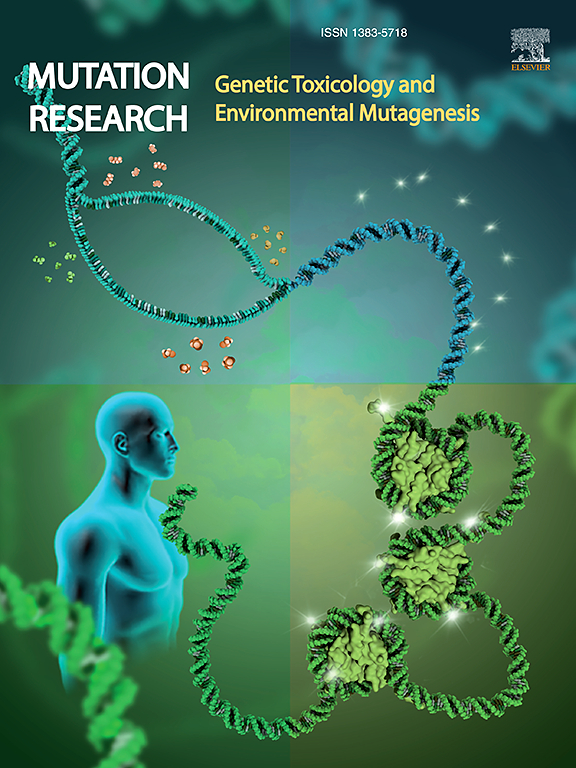Dose-response curve for induction of unstable chromosome aberrations by 6 MV linear accelerator photons: Analysis of intra-experimental variations
IF 2.5
4区 医学
Q3 BIOTECHNOLOGY & APPLIED MICROBIOLOGY
Mutation research. Genetic toxicology and environmental mutagenesis
Pub Date : 2025-02-01
DOI:10.1016/j.mrgentox.2025.503849
引用次数: 0
Abstract
Cytogenetic biodosimetry relies on dose-response curves (DRCs) for each type of radiation that can cause a radiation emergency. We have constructed a DRC based on the dicentric assay. Blood samples from four healthy volunteers were irradiated with acute 6 MV linac photons, 0.46–4.55 Gy; 0.68 and 1.37 Gy doses were used in the ‘blind’ validation study. Lymphocytes were cultured with variations in time delay in mitogenic stimulation after irradiation (2 vs. 16 h) and mitotic arrest by colchicine (3.5 vs. 16 h). Aberrations were scored in the first division metaphases, ensured by fluorescence-plus-Giemsa staining. DRCs for dicentrics and dicentrics plus centric rings were efficiently fitted using the linear-quadratic model. We show, for the first time, that neither prolonged mitotic arrest nor delayed mitogenic stimulation has any effect on DRC. However, the latter factor caused a significant increase in the yield of the second division metaphase in culture. Inter-donor differences in the DRC for aberrations were not large, but individual changes in the frequencies of second-division cells were highly variable. In the validation study, the DRC combined from all experimental series provided dose estimates that were as accurate as those, obtained using the donors’ individual or culture-type specific DRCs. The DRC coefficients in present study were slightly higher than those reported previously for linac beams and close to values for orthovoltage X-rays. Further cytogenetic studies of megavoltage radiation beams require stringent standardization of experimental conditions.
6 MV直线加速器光子诱导不稳定染色体畸变的剂量-响应曲线:实验内变异分析
细胞遗传学生物剂量学依赖于每种可能导致辐射紧急情况的辐射的剂量-反应曲线。我们建立了一个基于双中心分析的DRC。用急性6 MV直线光子(0.46-4.55 Gy)照射4名健康志愿者的血液样本;在“盲”验证研究中使用0.68和1.37 Gy剂量。培养的淋巴细胞在辐照后有丝分裂刺激的时间延迟(2 vs. 16 h)和秋水仙碱有丝分裂停止(3.5 vs. 16 h)有所不同。在第一分裂中期,用荧光加吉姆萨染色法对畸变进行评分。采用线性二次元模型对双心环和双心环加中心环进行了有效的拟合。我们首次表明,无论是延长有丝分裂停止还是延迟有丝分裂刺激对DRC都没有任何影响。但后一个因素在培养中使二分裂中期的产量显著增加。在DRC中,供体间的畸变差异不大,但二次分裂细胞频率的个体变化是高度可变的。在验证研究中,综合所有实验系列的DRC提供的剂量估计值与使用献血者个体或培养型特异性DRC获得的剂量估计值一样准确。本研究的DRC系数略高于先前报道的直线光束,接近于正电压x射线的值。进一步的巨压辐射束细胞遗传学研究需要严格的实验条件标准化。
本文章由计算机程序翻译,如有差异,请以英文原文为准。
求助全文
约1分钟内获得全文
求助全文
来源期刊
CiteScore
3.80
自引率
5.30%
发文量
84
审稿时长
105 days
期刊介绍:
Mutation Research - Genetic Toxicology and Environmental Mutagenesis (MRGTEM) publishes papers advancing knowledge in the field of genetic toxicology. Papers are welcomed in the following areas:
New developments in genotoxicity testing of chemical agents (e.g. improvements in methodology of assay systems and interpretation of results).
Alternatives to and refinement of the use of animals in genotoxicity testing.
Nano-genotoxicology, the study of genotoxicity hazards and risks related to novel man-made nanomaterials.
Studies of epigenetic changes in relation to genotoxic effects.
The use of structure-activity relationships in predicting genotoxic effects.
The isolation and chemical characterization of novel environmental mutagens.
The measurement of genotoxic effects in human populations, when accompanied by quantitative measurements of environmental or occupational exposures.
The application of novel technologies for assessing the hazard and risks associated with genotoxic substances (e.g. OMICS or other high-throughput approaches to genotoxicity testing).
MRGTEM is now accepting submissions for a new section of the journal: Current Topics in Genotoxicity Testing, that will be dedicated to the discussion of current issues relating to design, interpretation and strategic use of genotoxicity tests. This section is envisaged to include discussions relating to the development of new international testing guidelines, but also to wider topics in the field. The evaluation of contrasting or opposing viewpoints is welcomed as long as the presentation is in accordance with the journal''s aims, scope, and policies.

 求助内容:
求助内容: 应助结果提醒方式:
应助结果提醒方式:


